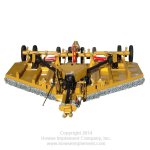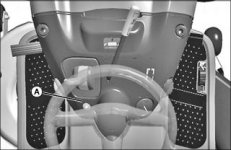aczlan
Good Morning
- Joined
- Mar 7, 2008
- Messages
- 17,540
- Tractor
- Kubota L3830GST, B7500HST, BX2660. Formerly: Case 480F LL, David Brown 880UE
That's been discussed on here before, it boils down to the terrain in the median is such that a rotary mower is the best option out there. Flails arent rugged enough to handle hitting rocks, tires, etc, etc ,etc without needing a lot more maintenance than a rotary mower. A couple of members on here do commercial ROW mowing and one of them (Farmwithjunk) said the following:
Aaron Z
This years contract requires me to mow 4 times (on or near specific dates) Only the very lasy mow of the year do we mow ALL the outside ROW's. They are cut to a maximum of 15' from edge of pavement on rounds 1, 2, and 3. It isn't unusual to have ROW's with as much as 75' of grass/weeds. So round 4 is done in some very hostile conditions.
Part of the bid is "trash clean up" that requires people on foot, bagging trash, and looking for potential problems. They can't see under the heavy growth. The clean up crews stay a couple days in front of the mowing crew. It's not far out of the realm of possibility that a passing motorist can toss something out between the time it's walked and the actual mowing takes place.
Quite often, rocks become dislodged from rock outcroppings along the ROW. THey weren't there one minute, there the next....
Point being, even when precautions are taken, often well beyond what would be expected as "enough", there's still a very strong likelyhood that SOMETHING is going to end up getting hit....and launched.
State budgets have been slashed in the last few years. (That ol' economy thing...AGAIN) We once mowed the same roadway, but TWO additional cuts per year. That MAY save the state a bit of money, but it also serves to leave us mowing in a less "friendly" environmant.
Typically, there isn't a very thick "cushion" in the bid prices on ROW mowing. I'm not interested in doing this as a "pro bono" project, but the bid has to be not only competitive, but it has to be LOW bid. Long story short, we can make a decent income with equipment budgets built upon lower initial cost and lower overall operating cost of rotary mowers, but not so much with flails. They aren't spec-ed in the bids we go after, and there simply isn't the money allocated for bids employing more expensive equipment. Simple explanation, we buy flails and we can't bid competitively.
So....We use 15' Bush Hog batwings, and we buy plenty of insurance. Thing is, we would even with flail mowers. We have demo-ed flails from various vendors. They do a splendid job, but at a cost.
In the 3 past seasons, with as many as 9 mowing rigs operating at times, we've not had one single reported incidence with an object striking a vehicle. 2 incidents were reported, BOTH involved vehicles running off the edge of the road and hitting our vehicles parked in emergency lanes. We may throw a rock now and then, but they throw cars at us...!
Much is made of the saftey issue. Do you know what the most common cause of injuries while mowing highway ROW's is? It's vehicles colliding with tractors/trucks/employees. (To the tune of roughly 75:1 ratio compared with flying debris. ) While flying debris gets ALL the attention, there's still a VERY low incidence of that happening relative to the number of mowing rigs in service across the country. In 3-1/2 years since my firm has been mowing highway ROW's, we have yet to have the first incidence of a motorist being hit. (While we HAVE had 3 tractors hit by cars while the tractors were mowing IN THE FLIPPIN' MEDIAN) The number of collisions is relative to the amount of hours spent "in the line of fire". Use flails....Mowing time expands 2 to 4 times what would be expected while using rotaries. (Smaller mowers/slower ground speeds) Hence, more time in "the line of fire". And that's not counting the hours spent parked along side the roadways repairing damage to flail mowers vs rotaries. Flails typically require more mowers operating at much lower ground speeds. So the saftey issue ends up being a virtual wash.... Those of us who've actually done this sort of work with BOTH types of mowers realize this part of the equasion. The industrial engineers who write bid specs for county/state/federal highway mowing contracts realize this too... There is your reason why they don't specify EITHER type of mower....Injuries per mile of highway mowed show NEITHER has an advantage when all is said and done. Use rotary mowers and we're off the roadway faster, hence less likelyhood of accident. MORE chance of actually making a buck for my troubles. There is MY "reality".
The cold hard reality is, the ONLY true safe way to mow highway ROW's would be to close the roads to vehicular traffic while they were being mowed. Any idea of how likely THAT is to happen?
Aaron Z

